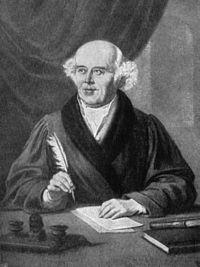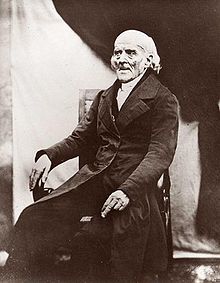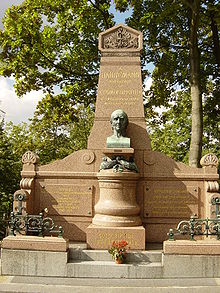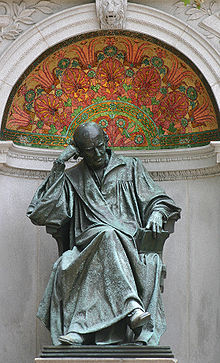- Samuel Hahnemann
-
Samuel Hahnemann 
Samuel HahnemannBorn 10 April 1755
Meissen, Electoral SaxonyDied 2 July 1843 (aged 88)
Paris, FranceNationality German Fields Homeopathy Christian Friedrich Samuel Hahnemann (10 April 1755[1] – 2 July 1843) was a German physician, known for creating an alternative form of medicine called homeopathy.
Contents
Early life
Christian Friedrich Samuel Hahnemann was born in Meissen, Saxony near Dresden. His father, along with many other family members, was a painter and designer of porcelain, for which the town of Meissen is famous.[2]
As a young man, Hahnemann became proficient in a number of languages, including English, French, Italian, Greek and Latin. He eventually made a living as a translator and teacher of languages, gaining further proficiency in "Arabic, Syriac, Chaldaic and Hebrew".[3]
Hahnemann studied medicine for two years at Leipzig. Citing Leipzig's lack of clinical facilities, he moved to Vienna, where he studied for ten months.[4] After one term of further study, he graduated MD at the University of Erlangen on 10 August 1779, qualifying with honors. His poverty may have forced him to choose Erlangen, as the school's fees were lower.[5] Hahnemann's thesis was titled Conspectus adfectuum spasmodicorum aetiologicus et therapeuticus. [A Dissertation on the Causes and Treatment of Cramps][6][7]
Medical practice
In 1781, Hahnemann took a village doctor’s position in the copper-mining area of Mansfeld, Saxony.[8] He soon married Johanna Henriette Kuchler and would eventually have eleven children.[3] After abandoning medical practice, and while working as a translator of scientific and medical textbooks,[9] Hahnemann travelled around Saxony for many years, staying in many different towns and villages for varying lengths of time, never living far from the River Elbe and settling at different times in Dresden, Torgau, Leipzig and Köthen (Anhalt) [10] before finally moving to Paris in June 1835.[11]
Creation of homeopathy
Hahnemann claimed that the medicine of his time did as much harm as good:
My sense of duty would not easily allow me to treat the unknown pathological state of my suffering brethren with these unknown medicines. The thought of becoming in this way a murderer or malefactor towards the life of my fellow human beings was most terrible to me, so terrible and disturbing that I wholly gave up my practice in the first years of my married life and occupied myself solely with chemistry and writing.[3]
After giving up his practice around 1784, Hahnemann made his living chiefly as a writer and translator, while resolving also to investigate the causes of medicine's alleged errors. While translating William Cullen's A Treatise on the Materia Medica, Hahnemann encountered the claim that cinchona, the bark of a Peruvian tree, was effective in treating malaria because of its astringency. Hahnemann believed that other astringent substances are not effective against malaria and began to research cinchona's effect on the human body by self-application. Noting that the drug induced malaria-like symptoms in himself, he concluded that it would do so in any healthy individual. This led him to postulate a healing principle: "that which can produce a set of symptoms in a healthy individual, can treat a sick individual who is manifesting a similar set of symptoms."[3] This principle, like cures like, became the basis for an approach to medicine which he gave the name homeopathy. He first used the term homeopathy in his essay Indications of the Homeopathic Employment of Medicines in Ordinary Practice, published in Hufeland's Journal in 1807.[12]
Development of homeopathy
Hahnemann tested substances for the effect they produced on a healthy individual and tried to deduce from this the ills they would heal. From his research, he initially concluded that ingesting substances to produce noticeable changes in the body resulted in toxic effects. He then attempted to mitigate this problem through exploring dilutions of the compounds he was testing. He claimed that these dilutions, when prepared according to his technique of succussion (systematic mixing through vigorous shaking) and potentization, were still effective in alleviating the same symptoms in the sick.
Hahnemann began practicing this new technique, which attracted other doctors c.1792.[citation needed] He first published an article about the homeopathic approach in a German language medical journal in 1796. Following a series of further essays, he published in 1810 'Organon of the Rational Art of Healing,' followed over the years by 4 further editions titled: The Organon of the Healing Art, the first systematic treatise and containing all his detailed instructions on the subject. A 6th Organon edition, unpublished during his lifetime, and dating from February 1842, was only published many years after his death. It consisted of a 5th Organon containing extensive handwritten annotations (A reading of each edition will demonstrate the extent of the revision and experience based additions) .[13] The Organon is widely regarded as a remodelled form of an essay he published in 1806 called "The Medicine of Experience," which had been published in Hufeland's Journal. Of the Organon, Dudgeon states it "was an amplification and extension of his "Medicine of Experience," worked up with greater care, and put into a more methodical and aphoristic form, after the model of the Hippocratic writings." [14]
The coffee theory
Around the start of the 19th century Hahnemann developed a theory, propounded in his 1803 essay On the Effects of Coffee from Original Observations, that many diseases are caused by coffee.[15] Hahnemann later abandoned the coffee theory in favour of the theory that disease is caused by Psora, but it has been noted that the list of conditions Hahnemann attributed to coffee was similar to his list of conditions caused by Psora. The coffee theory has been described as "a good example both of Hahnemann's superior mental powers and of his occasional tendency to make up a grand theory from scant evidence".[16]
Later life
In early 1811[17] Hahnemann moved his family back to Leipzig with the intention of teaching his new medical system at the University of Leipzig. As required by the university statutes, to become a faculty member he was required to submit and defend a thesis on a medical topic of his choice. On 26 June 1812, Hahnemann presented a Latin thesis, entitled "A Medical Historical Dissertation on the Helleborism of the Ancients."[18] His thesis very thoroughly examined the historical literature and sought to differentiate between the ancient use of Helleborus niger, or black hellebore and the medicinal uses of the "white hellebore," botanically Veratrum album, both of which are poisonous plants related to Buttercup and Magnolia.[19]
Hahnemann continued practicing and researching homeopathy, as well as writing and lecturing for the rest of his life. He died in 1843 in Paris, at 88 years of age, and is entombed in a mausoleum at Paris's Père Lachaise cemetery.
Descendants
While there are a few living descendants of Hahnemann’s older sister Charlotte (1752–1812),[20] there is only one known living descendant of Hahnemann himself, Mr Charles Tankard-Hahnemann (7th generation descendant of Dr Samuel Hahnemann)[21]
His father, Mr William Herbert Tankard-Hahnemann (1922–2009), the great, great, great grandson of Samuel Hahnemann died on 12 January 2009 (his 87th birthday) after 22 years of active patronage of the British Institute of Homœopathy.[22] As a young boy, William remembered his mother telling him of her visits to her ‘grand-dad Leo’ at Ventnor, Isle of Wight. Later William Hahnemann knew that this was Dr Leopold Süβ-Hahnemann, Dr Samuel Hahnemann’s grandson, the only son of his favourite daughter Amelie (1789–1881). Dr Süβ-Hahnemann was the only member of the Hahnemann family to be present at Samuel Hahnemann’s funeral, apart from Hahnemann’s second wife Mélanie, in Paris in 1843 and at his subsequent re-burial in the Père Lachaise Cemetery in east Paris, where only persons of truly notable distinction are interred. Subsequently Leopold emigrated from France to England where he practised homœopathy in London. He retired to the Isle of Wight and died there at the outbreak of World War I in 1914. Dr Leopold Süβ-Hahnemann’s youngest daughter, Amalia had two children, Winifred (born 1898) and Herbert. Mr William Tankard-Hahnemann was Winifred’s son. Apart from serving as the patron of the British Institute of Homœopathy, he also had a distinguished career in the City of London and was honoured by being appointed as a ‘Freeman of the City of London’.[citation needed]
Writings
Hahnemann wrote a number of books, essays, and letters on the homeopathic method, chemistry, and general medicine:
- Heilkunde der Erfahrung. Norderstedt 2010, ISBN 3842313268
- (in German) Versuch über ein neues Prinzip zur Auffindung der Heilkräfte der Arzneisubstanzen, nebst einigen Blicken auf die bisherigen [Essay on a New Principle for Ascertaining the Curative Powers of Drugs], 1796, http://www.mickler.de/journal/versuch-prinzip-1.htm reprinted in Versuch über ein neues Prinzip zur Auffindung der Heilkräfte der Arzneisubstanzen, nebst einigen Blicken auf die bisherigen, Haug, 1988, ISBN 3776010606
- Fragmenta de viribus medicamentorum positivis, a collection of 27 drug "provings" published in Latin in 1805.[23][24][25]
- The Organon of the Healing Art (1810), a detailed delineation of what he saw as the rationale underpinning homeopathic medicine, and guidelines for practice. Hahnemann published the 5th edition in 1833; a revised draft of this (1842) was discovered after Hahnemann's death and finally published as the 6th edition in 1921.[26][27][28][29]
- Materia Medica Pura, a compilation of "homoeopathic proving" reports, published in six volumes between vol. I in 1811 and vol. VI in 1827. Revised editions of volumes I and II were published in 1830 and 1833, respectively.[30]
- Chronic Diseases (1828), an explanation of the root and cure of chronic disease according to the theory of miasms, together with a compilation of "homoeopathic proving" reports, published in five volumes during the 1830s.
- Lesser Writings of Samuel Hahnemann, http://www.minutus.org/library/article_showall.asp?cat_id=1&parent_id=1&parent_name=Articles&sub_name=Samuel+Hahnemann, which were gathered by Dudgeon.
- The Friend of Health, in which Hahnemann "recommended the use of fresh air, bed rest, proper diet, sunshine, public hygiene and numerous other beneficial measures at a time when many other physicians considered them of no value."[31][32]
- Appeal to Thinking Philanthropist Respecting the Mode of Propagation of the Asiatic Choler, in which Hahnemann describes cholera physicians and nurses as the "certain and frequent propagators" of cholera and that whilst deriding nurses' "fumigations with chlorine", promoted the use of "drops of camphorated spirit" as a cure for the disease.[33]
- Hahnemann also campaigned for the humane treatment of the insane in 1792[34]
- John Henry Clarke wrote that "In 1787, Hahnemann discovered the best test for arsenic and other poisons in wine, having pointed out the unreliable nature of the "Wurtemberg Test," which had been in use up to that date." [35][36]
See also
Notes
- ^ Though some sources do state that he was born in the early hours of 11 April 1755, Haehl, Richard (1922), Samuel Hahnemann his Life and Works, 1, p. 9, "Hahnemann, was born on 10 April at approximately twelve o'clock midnight."
- ^ Harris Livermore Coulter (1977), Divided Legacy, a History of the Schism in Medical Thought, II, Washington: Wehawken Books, pp. 306, ISBN 0916386023, OCLC 67493911
- ^ a b c d Hahnemann Biography, http://www.skylarkbooks.co.uk/Hahnemann_Biography.htm, retrieved 2009-01-13
- ^ Martin Kaufman (1972), Homeopathy in America, the Rise and Fall of a Medical Heresy, Baltimore: Johns Hopkins University Press, pp. 24, ISBN 0801812380, OCLC 264319
- ^ Haehl, op cit, vol. 1, p.24
- ^ Trevor Cook (1981), Samuel Hahnemann Founder of Homeopathy, Wellingborough, Northamptonshire: Thorsons, p. 36, ISBN 0722506899
- ^ Richard Haehl (1922), Samuel Hahnemann His Life and Work, 2, London: Homoeopathic Publishing, pp. 11, OCLC 14558215
- ^ Haehl, op cit, vol. 1, p.26
- ^ Bradford, Thomas L, The Life and Letters of Hahnemann, 1895, pp.515-516
- ^ Cook, Trevor, Samuel Hahnemann, the Founder of Homeopathy, Thorsons, UK, 1981, pp.83-4,
- ^ Cook, p.168
- ^ Martin Gumpert, Hahnemann: The Adventurous Career of a Medical Rebel, New York: Fischer, 1945, p.130
- ^ Sixth Organon book review
- ^ R H Dudgeon, Lectures on the Theory and Practice of Homeopathy, London: Henry Turner, 1853, p.xxxi
- ^ Hahnemann S (1803): On the Effects of Coffee from Original Observations, in Hahnemann S, Dudgeon R E (ed)(1852): The lesser writings of Samuel Hahnemann. New York: William Radde, p.391
- ^ Morrell, P (1996): On Hahnemann's coffee theory, www.homeoint.org
- ^ Thomas Lindsley Bradford (1895 (reprinted 1999)), The Life and Letters of Samuel Hahnemann, Philadelphia: Boericke & Tafel, p. 76, OCLC 1489955
- ^ Bradford, op cit, p.93
- ^ Richard Haehl, Samuel Hahnemann, his Life and Work, Vol. 2, p.96
- ^ http://homeoint.org/seror/articles2/famillesh.htm
- ^ http://www.britinsthom.com/index.php?option=com
- ^ http://www.hpathy.com/biography/william-herbert-tankard-hahnemann.asp
- ^ (in Latin) Fragmenta de viribus medicamentorum positivis, sive in sano corpore humano observatis, 1824, OCLC 14852975, http://www.archive.org/details/fragmentadeviri00hahngoog
- ^ (in German) (PDF) Übersetzung der 'Fragmenta de viribus medicamentorum' von Marion Wettemann, http://www.hahnemann.de/frontend1/media/pdf/fragmenta_leseprobe.pdf[dubious ]
- ^ http://www.homeoint.org/seror/pathohahn/index.htm Fragmenta de viribus and Materia Medica Pura full-text in French
- ^ Online etext of Hahnemann's Organon der Heilkunst
- ^ Organon of Homeopathy, 6th version English version, full text online
- ^ http://www.homeoint.org/books4/organon/ German original] (other format)
- ^ http://www.homeopathyhome.com/reference/organon/organon.html English translation
- ^ http://www.hpathy.com/materiamedica/hahnemann-materia-pura/index.asp Hahnemann's Materia Medica Pura full-text in English
- ^ Rothstein, William G, American Physicians in the Nineteenth Century: from Sects to Science, Baltimore: Johns Hopkins University Press, 1972, p.158
- ^ Samuel Hahnemann (1792), The Friend of Health
- ^ Samuel Hahnemann (1831), "Appeal to Thinking Philanthropist Respecting the Mode of Propagation of the Asiatic Choler", The lesser writings of Samuel Hahnemann: pp. 753–63, OCLC 3440881, http://www.archive.org/details/lesserwritingss00hahngoog
- ^ Samuel Hahnemann (1796), "Description of Klockenbring During his Insanity", The lesser writings of Samuel Hahnemann: pp. 243–9, OCLC 3440881, http://www.archive.org/details/lesserwritingss00hahngoog
- ^ John Henry Clarke (1894), Homoeopathy: all about it; or, The principle of cure, London: Homoeopathic Publishing, OCLC 29160937
- ^ Richard Haehl, Marie L. Wheeler (tr.) and W.H.R. Grundy (tr.) (1922), John Henry Clarke, Francis James Wheeler, ed., Samuel Hahnemann his Life and Work, 1, London: Homoeopathic Publishing, pp. 34, OCLC 222833661, http://www.archive.org/details/samuelhahnemannh01haehuoft, reprinted as ISBN 81-7021-693-1
Bibliography
- Brockmeyer, Bettina (2007), "[Representations of illness in letters addressed to Samuel Hahnemann: gender and historical perspectives]" (in German), Medizin, Gesellschaft, und Geschichte : Jahrbuch des Instituts für Geschichte der Medizin der Robert Bosch Stiftung 29: 211–21, 259, PMID 18354994
- Kayne, Steven (2006), "Samuel Hahnemann (1755-1843): the founder of modern homeopathy.", Pharmaceutical historian 36 (2 Suppl): S23–6, 2006 Jun, PMID 17153748
- Brockmeyer, Bettina (2005), "[Writing about oneself and others: men and women in letters to doctor Samuel Hahnemann 1831-1835]" (in German), Würzburger medizinhistorische Mitteilungen / im Auftrage der Würzburger medizinhistorischen Gesellschaft und in Verbindung mit dem Institut für Geschichte der Medizin der Universität Würzburg 24: 18–28, PMID 17153289
- "[Biographic synopsis on Samuel Hahnemann]" (in Spanish), Revista de enfermería (Barcelona, Spain) 28 (3): 10–6, 2005, 2005 Mar, PMID 15871338
- Eschenbruch, Nicholas (2005), "[Rationalist, magician, scharlatan? Samuel Hahnemann and homeopathy from the viewpoint of homeopathy]" (in German), Schweiz. Rundsch. Med. Prax. 94 (11): 443–6, 2005 Mar 16, PMID 15822443
- Jutte, R (1999), "["Thus it passes from the patient's purse into that of the doctor without causing displeasure" - Samuel Hahnemann and medical fees]" (in German), Medizin, Gesellschaft, und Geschichte : Jahrbuch des Instituts für Geschichte der Medizin der Robert Bosch Stiftung 18: 149–67, PMID 11624613
- de Goeij, C M (1994), "[Samuel Hahnemann: an indignant systems builder]" (in Dutch), Nederlands tijdschrift voor geneeskunde 138 (6): 310–4, 1994 Feb 5, PMID 8121514
- Rizza, E (1994), "[Samuel Hahnemann: a mystical empiricist. A study of the origin and development of the homeopathic medical system]" (in Italian), Medicina nei secoli 6 (3): 515–24, PMID 11620590
- Meissner, M (1992), "[Samuel Hahnemann--the originator of homeopathic medicine]", Krankenpflege Journal 30 (7–8): 364–6, PMID 1405462
- Schmidt, J M (1988), "[The publications of Samuel Hahnemann]", Sudhoffs Archiv 72 (1): 14–36, PMID 2970128
- Lozowski, J (1982), "[Homeopathy (Samuel Hahnemann)]" (in Polish), Pielȩgniarka i połozna (4–5): 16–7, PMID 6750668
- Habacher, M (1980), "Homöopathische Fernbehandlung durch Samuel Hahnemann" (in German), Medizinhistorisches Journal 15 (4): 385–91, PMID 11610925
- Antall, J; Kapronczay, K (1973), "[Samuel Hahnemann]", Orvosi hetilap 114 (32): 1945–7, 1973 Aug 12, PMID 4581537
- Hodges, PC (1964), "Homeopathy and Christian Friedrich Samuel Hahnemann", Postgraduate medicine 35: 666–8, 1964 Jun, PMID 14143315
- Dietrich, HJ (1958), "Hahnemann's capacity for greatness; Samuel Hahnemann; and Hahnemann Medical College", The Hahnemannian 93 (2): 35–9, PMID 13562700
- Koch, E (1955), "[On the 200th anniversary of Dr. Samuel Hahnemann; several ideas concerning homeopathy]" (in German), Das Deutsche Gesundheitswesen 10 (16): 585–90, 1955 Apr 21, PMID 14379841
- Auster, F (1955), "[200th Anniversary of the birth of Dr. Samuel Hahnemann, born April 10, 1755]" (in German), Pharmazeutische Zentralhalle für Deutschland 94 (4): 124–8, 1955 Apr, PMID 14384489
External links
- Works by Samuel Hahnemann on Open Library at the Internet Archive
- Life History of Samuel Hahnemann
- Christian Friedrich Samuel Hahnemann A historical overview
- Hahnemann Building, Hope Street, Liverpool former site of the Hahnemann Hospital, Liverpool
 "Hahnemann, Samuel Christian Friedrich". The American Cyclopædia. 1879.
"Hahnemann, Samuel Christian Friedrich". The American Cyclopædia. 1879.
Topics in Homeopathy Reference material Homeopaths S. Hahnemann · J.T. Kent · C. von Bönninghausen · J.H.Clarke · E. B. Nash · L. De Schepper · G.Vithoulkas · Peter Fisher · John Franklin Gray · Melanie Hahnemann · Charles Julius Hempel · Constantine Hering · Paul Herscu · Elizabeth Wright Hubbard · George Heinrich Gottlieb Jahr · Frederic Hervey Foster Quin · Rajan Sankaran · Jan Scholten · Jeremy Sherr · Guy Beckley Stearns · Dana UllmanOrganizations Related See also Categories:- 1755 births
- 1843 deaths
- 18th-century Latin-language writers
- 19th-century Latin-language writers
- Burials at Père Lachaise Cemetery
- German physicians
- 18th-century German physicians
- Homeopaths
- People from Meissen
- People from the Electorate of Saxony
- University of Erlangen-Nuremberg alumni
Wikimedia Foundation. 2010.



